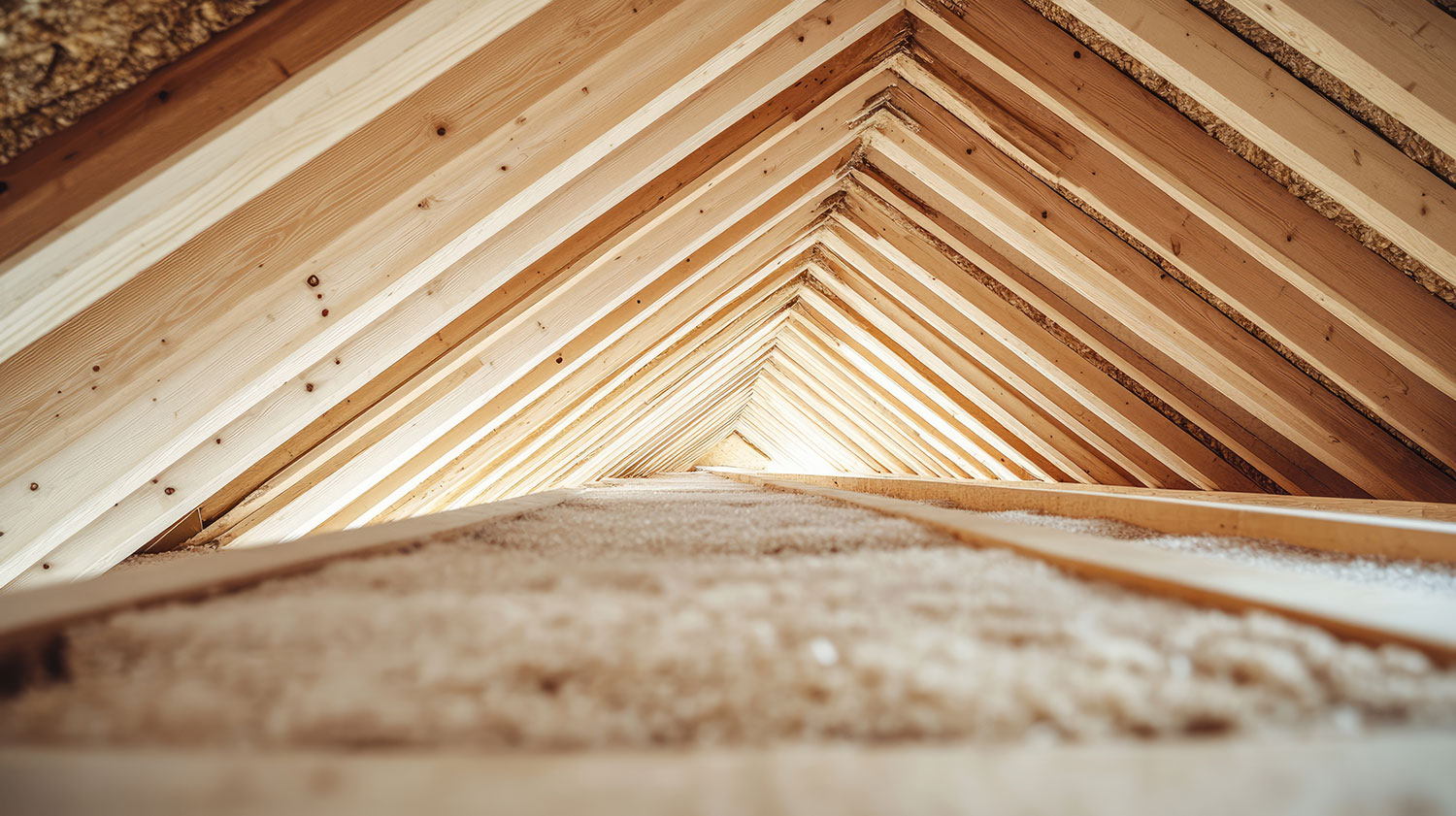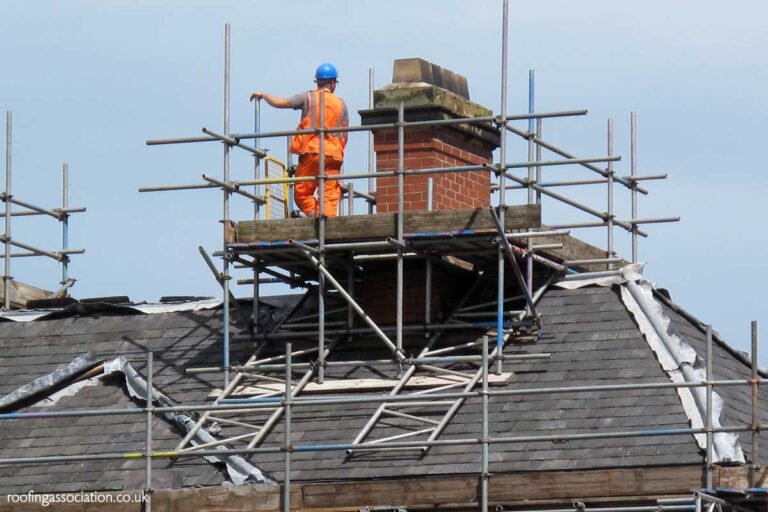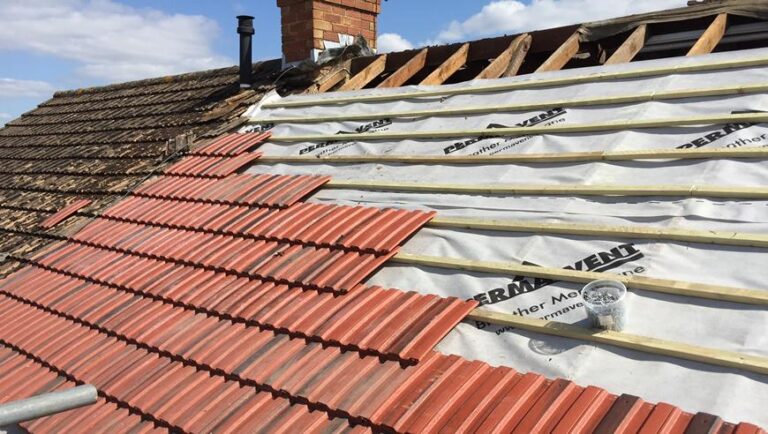Have you ever gotten into your loft and noticed light shining through holes in your felt and wondered can it be repaired from the loft? You may have considered carrying out patch repairs from inside the loft yourself but are unsure if it works. It is a more appealing choice than braving the ladder and slippery roof tiles. Continue reading to find out what repairs can be done from inside your loft.
What Exactly is Roof Felt?
Roof felt, often called sarking felt, is a membrane laid between your roof tiles and the roof structure.
It serves several key purposes:
- Roofing felt is a second layer of protection that goes under the tiles.
- Reduces drafts and breathable membranes now help the roof to breath.
- Helps direct any water ingress into gutters, away from your home’s interior.
Roof felt started to be installed on most British homes after 1930. There are different types of roof felt, the older versions used bitumen based where as modern day felts are lightweight and breathable membranes to help with roof ventilation.
Why Roof Felt Gets Damaged
Several issues can cause roof felt to fail over time:
- Age and weathering as older felts are not as durable so crack and deteriorate.
- Old thick felts cause condensation on the cold side of the felt, especially in poorly ventilated roofs.
- Damage during storms or when people are working on the roof or in the loft.
- Rodents or birds can chew the felt and enter the roof space.
- Fallen tiles or tree branches can tear the membrane.
Your first step is to assess the condition of the roofing felt, if it seems brittle then carrying out any roof repair works from the loft may only make the problem worse.
Repairing Roof Felt: Loft vs. Roof Access
Below is a comparison on carrying out roof repairs from the loft and from outside on the roof:
Approach | Pros | Cons |
|---|---|---|
From inside the loft | Avoids working at height. Weather less of a concern. Faster for small repairs. | Hard to reach felt above tight rafters. Won’t address missing tiles. May not provide a lasting seal. |
By accessing the roof | Full access to the damaged area. Easy to replace large sections. | Requires ladder, scaffold, or professional help. Weather dependent. Higher risk of falling. |
Many are drawn to the idea of a quick, safe fix from within the loft. The reality: it is sometimes possible, but there are clear limits.
What Can Be Repaired from Inside?
Small rips, holes, or minor splits in the roof felt can occasionally be patched from inside the loft. The success of such repairs depends on:
- The location: easy to reach flat sections are the most straightforward.
- The extent of damage: anything larger than a few centimetres is challenging.
- The condition of surrounding felt: if the area is brittle and flaking, patching may fail.
Common interior repair tasks include:
- Applying bitumen-based felt repair tape over splits.
- Smoothing on cold applied roofing mastic for tiny holes.
- Patching with offcuts of breathable membrane, fixed with staples and sealed at the edges.
Problems hidden near the eaves or under overlapping rafters are much tougher to deal with from inside.
Step-by-Step Guide: Patching a Minor Tear from Inside
- Locate The Issue – Move or roll back any insulation and check for water staining. Use a torch so you can see better.
- Prepare The Area – Clear the area and dry the felt before doing any repairs.
- Trim And Clean Up Torn Edges – If the felt is fraying, trim away and tidy the felt for a flat working surface.
- Apply The Patch Or Tape – Use repair tape to patch over the hole, ensure you use a section of tape large the the tear.
- Seal The Edges – Apply roofing mastic around the patch to prevent future water ingress. Smooth down so there are no gaps.
- Reinsulate – Once finished clean up and put the insulation back in place.
These types of repairs are easier and cheaper but are only a short term fix. This may get you through another winter or storm but the repair has a shelf life and you should consider a better solution in the future.
Should You Attempt a DIY Inner Loft Repair?
Think carefully before reaching for your toolbox. Ask yourself:
- Is the damage very small and easy to reach?
- Are the roof’s tiles intact?
- Can I safely work in the loft, with secure footing?
- Am I comfortable using protective equipment and handling mastic or adhesive products?
If any of those get a ‘no’, it’s time to call in a roofer.
DIY repairs make sense for neat, shallow tears. Anything more, or signs of wood rot require expert attention.
What Problems Will a Loft-Based Patch NOT Solve?
It’s easy to become overconfident after a neat interior patch. However, certain issues always demand proper, external repair:
- Felt that has deteriorated over wide areas.
- Tears or holes near the eaves, where felt guides water into the guttering.
- Missing or slipped tiles above the damaged felt.
- Rotten or sagging timbers beneath the felt.
- Large or repeated leaks that have soaked through insulation and ceiling plaster.
In many cases, water marks on your loft’s insulation are a sign that the tiles above need replacing or repositioning, not just the felt.
When is Professional Help Absolutely Necessary?
Some situations are simply too complex or risky for DIY repairs. Consider contacting a roofer if:
- The leak is persistent, worsening, or coming from multiple spots.
- There’s structural damage to the rafters or trusses.
- You spot daylight through the roof above.
- Large parts of the felt are hanging loose or are absent.
- The area is close to electrical wiring or the loft hatch, posing extra risk.
Professional roofers can:
- Lift roof tiles and renew entire strips of felt.
- Replace rotten wood.
- Fit eaves trays or breathable membranes for improved ventilation.
- Provide guarantees for their work.
Safety should always outweigh convenience.
Is Modern Roofing Felt Different?
Traditional bitumen felts, common in British homes up to the 1980s, tend to become brittle and tear under stress. Newer ‘breathable’ felts are lighter, resist decay, and are easier to patch (but often less sticky).
Some homes combine felt with plastic eaves trays to prevent the sagging often seen where old felt disintegrates. Patching a breathable membrane requires different adhesives, cold-applied mastic is often suitable, but check the manufacturer’s guidance before applying anything.
Preventing Further Damage
If you have carried out a patch repair in the loft there are some measures you can take to help prevent further damage such as:
- Check that loft insulation is not bocking the eaves so that the roof has airflow to breath.
- Pop your head in the loft more regular to keep an eye out for any birds, rodents or insects that could cause damage.
- Book a roof inspection once a year with a professional roofer.
- Don’t store too many items near rafters or block ventilation points.
What’s left unchecked today can become a major leak next winter.
Common Questions about Roof Felt Repairs
Do I need to replace all the felt if there’s a small tear? No. Small, isolated tears can be patched. Only widespread damage needs a full re-felt.
Is roof felt breathable? Newer types are, allowing moisture to escape the loft. Older, black bitumen felts are not.
How do I know if water stains in the loft are from felt damage? Check for missing or slipped tiles directly above the stain. If none are visible, suspect the felt.
Can I use regular duct tape or tarpaulin to fix the felt? No. Use dedicated roofing repair tapes or patches for a proper seal.
Should I add more insulation to keep water away from the ceiling? Insulation does not stop leaks. Focus on waterproofing instead.
Typical Costs: DIY vs Professional
Cost often dictates the first step. Here’s a comparison for patching 2–3 minor felt tears:
Task | DIY Materials (£) | Professional Fix (£) |
|---|---|---|
Repair tape + mastic | £12–£25 | – |
Professional visit to patch felt | – | £80–£200 |
Full re-felt (average 3-bed semi) | – | £1,800–£4,500 |
For repeated issues, investing in a full re-felt proves cheaper in the long run.
A Safer, Drier Home
Tackling roof felt fixes from the loft can be tempting, especially on miserable rainy days. While it’s suitable for minor, accessible faults, the bigger the issue, the stronger the case for skilled help.
Next time you notice stains on your insulation or a drip above the attic hatch, remember: a well-maintained roof felt is silent, invisible, and utterly vital for your home’s well-being. A patch inside the loft might buy you time, but never skip regular checks or riskier repairs if your home’s future is at stake. For more information or to book a roof inspection contact the Point Roofing & Guttering team.







